Unlocking the Connection: How Chiropractic Adjustments Influence Your Nervous and Motor Systems
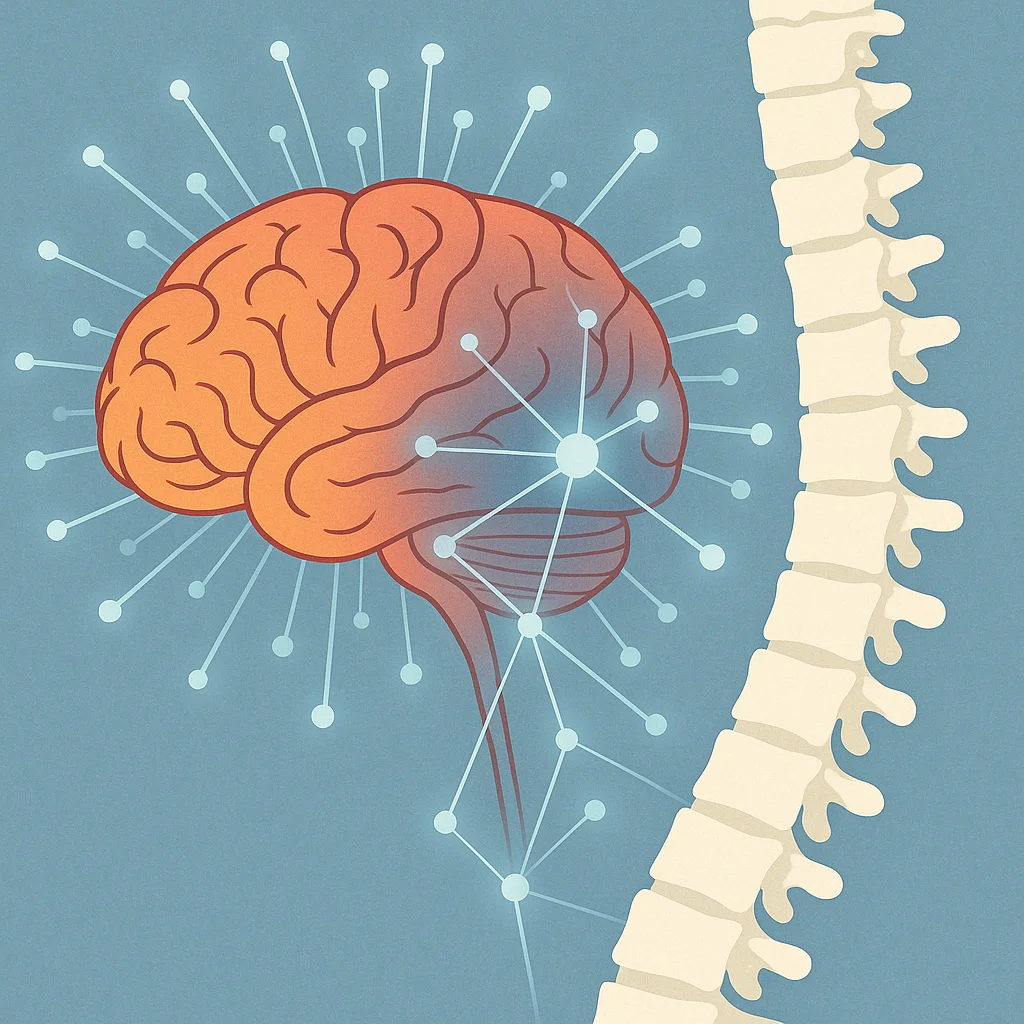
When most people think about a chiropractic adjustment, they imagine a quick “crack” to relieve back or neck pain. While adjustments can relieve pain and improve mobility, research is showing that their effects go far deeper—reaching into how your brain and nervous system communicate with the rest of your body. Let’s break it down: The Nervous System: Your Body’s Command Center Your nervous system includes your brain, spinal cord, and all the nerves branching out to your limbs and organs. It controls everything from your movements to how you feel pain, balance, and even how well your muscles fire during activity. When your spine isn’t moving properly—or certain joints are restricted—it can interfere with the signals traveling between your brain and body. This is where chiropractic care comes in. What Does a Chiropractic Adjustment Do? A chiropractic adjustment helps restore proper movement in the spine or joints. But beyond simply improving range of motion, it also sends powerful signals to your nervous system. Think of it as “rebooting” certain pathways that may not be functioning optimally. Adjustments and the Brain-Body Connection Recent studies using tools like EEG (electroencephalography) and EMG (electromyography) have shown that spinal adjustments can lead to changes in how the brain processes sensory and motor information. Here’s what that means: Improved Brain Processing: One study found that after a spinal adjustment, the brain becomes better at integrating and responding to sensory input (like balance, movement, and coordination). This may explain why many patients report feeling more “connected” or “grounded” after treatment. Enhanced Muscle Control: Another study found that after just one spinal adjustment, there was increased muscle activation in the legs. This suggests adjustments may help your body recruit muscles more efficiently, which can benefit performance, stability, and even reduce injury risk. Refined Motor Planning: Your brain doesn’t just react—it also plans how your body will move. Chiropractic adjustments appear to influence this planning stage, helping fine-tune motor control before a movement even happens. So, Why Does This Matter? If you’ve ever thought of chiropractic care as just about pain relief or posture, think again. The adjustment is not just mechanical—it’s neurological. Every time your chiropractor adjusts your spine, they may be helping your brain process movement, balance, and coordination more effectively. These subtle changes in the nervous system could be why so many people report feeling clearer, more mobile, and more balanced after care. A Ripple Effect Throughout the Body Think of your nervous system like a Wi-Fi network. If your spine isn’t moving well, it’s like having a poor signal. A chiropractic adjustment can boost that signal—not just to relieve pain, but to enhance the entire way your body communicates and moves. In short, chiropractic care isn’t only about treating symptoms. It’s about optimizing how your brain and body work together. For more information, you can book a free consultation or schedule an appointment with us by clicking the buttons down below 👇 Book a Free Consultation Book an Appointment References: Haavik H, Niazi IK, Holt K, et al. (2021). The Impact of Spinal Manipulation on Cortical Drive to Upper and Lower Limb Muscles. Brain Sciences, 11(1), 12. https://pubmed.ncbi.nlm.nih.gov/33466707/ Haavik H, Kumari N, Holt K, et al. (2021). The Effects of a Single Session of Spinal Manipulation on Strength and Cortical Drive in Athletes. Brain Sciences, 11(6), 773. https://pubmed.ncbi.nlm.nih.gov/34164712/ Haavik H, Murphy B. (2012). Translating basic science into practice: what are the potential effects of spinal manipulation on the brain? Chiropractic & Manual Therapies, 20, 19. https://pubmed.ncbi.nlm.nih.gov/22483612/
How Chiropractic Care Can Help Relieve Sciatica

If you’ve ever experienced sciatica, you know how disruptive it can be. That sharp, shooting pain that radiates from your lower back down your leg can interfere with everything from sitting comfortably to enjoying your daily activities. . The good news? Chiropractic care offers a safe, non-invasive way to help manage and relieve sciatica pain. What Is Sciatica? Sciatica refers to irritation or compression of the sciatic nerve—the largest nerve in your body. Symptoms include lower back pain, numbness, tingling, or weakness that travels into the buttock and leg. It usually affects one side and may be triggered by a herniated disc, spinal misalignment, muscle tension (especially in the piriformis), or narrowing of the spinal canal (spinal stenosis). How Can Chiropractic Help? Chiropractors are trained to assess and treat the musculoskeletal system, including conditions like sciatica. After a thorough assessment, a chiropractor can develop a personalized care plan to manage symptoms and prevent then from returning. Depending on the cause, there are various ways a chiropractor can treat and manage sciatic-type symptoms: Spinal Adjustments:Gentle, controlled spinal manipulations help improve alignment, reduce pressure on the sciatic nerve, and restore proper joint movement. This can alleviate pain and improve mobility. Soft Tissue Therapy:Techniques like myofascial release, trigger point therapy, or cupping can target tight muscles or fascia that may be contributing to nerve irritation, especially in the gluteal region. Acupuncture and Modalities:Some chiropractors use adjunct therapies such as acupuncture or therapeutic laser therapy to reduce inflammation, promote healing, and improve circulation in affected areas. Movement & Rehabilitation:Chiropractors often prescribe specific exercises to stretch tight muscles, strengthen weak muscles and/or take pressure off an aggravated disc – which can help to reduce pain and the risk of future flare-ups. Education & Ergonomics:Identifying and correcting aggravating postures or activities —like prolonged sitting or poor lifting technique—can make a big difference in recovery and long-term prevention. When to Seek Help If your sciatic pain persists for more than a few days, worsens with activity, or is accompanied by weakness or numbness, it’s a good idea to seek professional care. Chiropractic can be a highly effective conservative option, and in some cases, may prevent the need for medication or surgery. The Bottom Line Chiropractic care offers a holistic and hands-on approach to managing sciatica pain. Through spinal adjustments, soft tissue therapy, movement education, and targeted rehab, chiropractors aim not just to relieve your current pain—but to help you move better and feel better for the long term. For more information, you can book a free consultation or schedule an appointment with us by clicking the buttons down below 👇 Book a Free Consultation Book an Appointment
Chiropractic Care During Pregnancy: Enhancing Comfort and Supporting a Healthy Journey
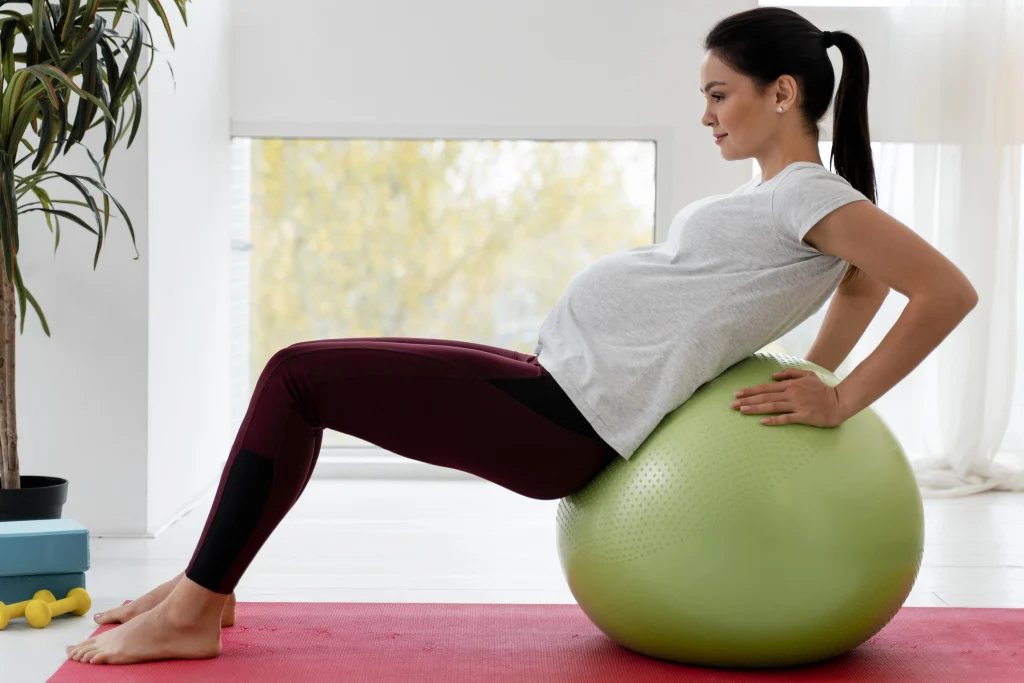
Pregnancy is a transformative time, bringing many physical changes. As the body adapts to support a growing baby, many expectant mothers experience discomforts such as back pain, pelvic pressure, and joint stiffness. Chiropractic care offers a non-invasive, drug-free approach to alleviate these discomforts and promote overall well-being during pregnancy. Benefits of Prenatal Chiropractic Care Alleviation of Back and Pelvic Pain – As pregnancy progresses, hormonal changes and a shifting center of gravity can lead to spinal strain and misalignments, resulting in lower back and pelvic pain. Chiropractic adjustments can help balance the spine and pelvis, reducing discomfort and improving mobility. Optimal Fetal Positioning – Proper pelvic alignment is crucial for the baby’s positioning in the womb. Chiropractic care can help maintain pelvic balance, potentially reducing the risk of a breeched presentation and facilitating a smoother delivery. Enhanced Nervous System Function – The nervous system plays a vital role in overall health. Chiropractic care supports nervous system function by addressing spinal misalignments, which can improve sleep quality, digestion, and energy levels during pregnancy. Safety Considerations Chiropractic care is generally considered safe during pregnancy when performed by a practitioner trained in prenatal techniques. These professionals use specialized methods to accommodate the anatomical changes of pregnancy, ensuring comfort and safety for both mother and baby. Conclusion Incorporating chiropractic care into prenatal health routines can offer significant benefits, from pain relief to improved overall wellness. As always, it’s essential to consult with your healthcare provider before beginning any new treatment during pregnancy. With the right support, chiropractic care can be a valuable component of a healthy, comfortable pregnancy journey. References Links: https://chiropractic.ca/chiropractic-care-for-pregnant-patients/ https://www.henryford.com/blog/2020/11/how-chiropractic-care-can-promote-healthy-pregnancy https://www.healthline.com/health/pregnancy/chiropractor-while-pregnant
Stay Active and Injury-Free: 8 Summer Fitness Tips for a Healthy Back
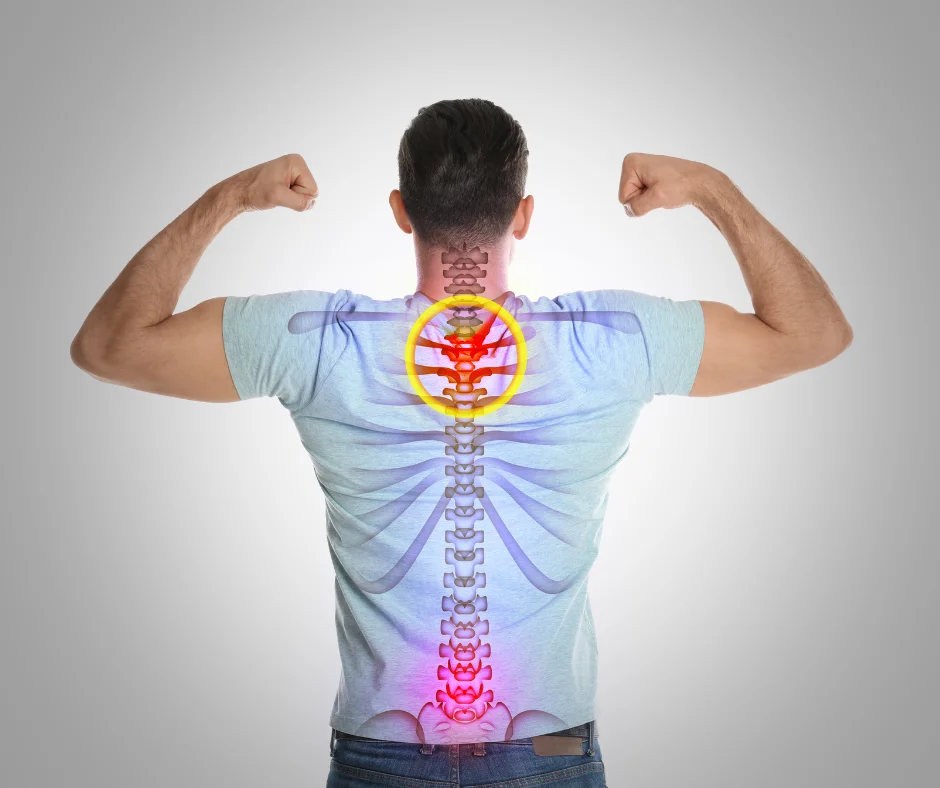
Summer is the perfect time to embrace outdoor activities—whether it’s gardening, golfing, running, or simply enjoying nature. These pursuits not only boost your mood but also enhance mobility, strengthen bones, and alleviate stress. However, it’s essential to approach them mindfully to prevent back injuries and ensure long-term wellness. Here are eight expert-backed tips to keep your back healthy and your body thriving this summer: 1. Start with a Gentle Warm-Up Before diving into any activity, take a few minutes to prepare your body. A brisk 5-minute walk followed by dynamic stretches can increase blood flow and loosen muscles, reducing the risk of injury. For instance, if you’re heading out for a run, incorporate leg swings and hip circles to activate key muscle groups. 2. Master Proper Techniques Using the correct form is crucial to prevent injuries. Gardeners should opt for kneeling instead of bending when planting. Golfers might benefit from professional lessons to refine their swing and avoid repetitive strain. Remember, quality trumps quantity—prioritize proper technique over extended durations. 3. Enhance Mobility and Flexibility Regular stretching and mobility exercises can significantly improve your range of motion. Incorporate routines that target major muscle groups, such as yoga or Pilates, to maintain flexibility. For example, runners should focus on calf and hamstring stretches to support optimal performance. 4. Stay Hydrated Hydration is key, especially during warmer months. Drink water before, during, and after physical activities. Dehydration can lead to muscle cramps, decreased coordination, and increased risk of injury. Consider carrying a reusable water bottle to ensure consistent intake. 5. Pace Yourself Avoid the temptation to overexert, especially if you’re returning to an activity after a hiatus. Break tasks into manageable segments—for instance, tackle gardening in 30-minute intervals with short breaks in between. This approach helps prevent fatigue and reduces strain on your back. 6. Cool Down Properly After completing your activity, dedicate time to cool down. Engage in gentle stretches and deep breathing exercises to help your body transition to a resting state. This practice aids in muscle recovery and reduces post-activity stiffness. 7. Dress Appropriately Wearing the right gear can make a significant difference. Choose supportive footwear that aligns with your activity—running shoes for jogging, sturdy boots for hiking, etc. Additionally, opt for breathable, moisture-wicking clothing to stay comfortable and prevent overheating. 8. Listen to Your Body Pay attention to any signs of discomfort or fatigue. Persistent pain is a signal to rest and, if necessary, consult a healthcare professional. Chiropractors can assess musculoskeletal issues and provide guidance on safe activity modifications. Bonus Tip: Incorporate Strength Training Building core strength supports spinal health and enhances overall stability. Integrate exercises like planks, bridges, and resistance band workouts into your routine to fortify your back and prevent injuries. Final Thoughts Embracing an active lifestyle during summer is both enjoyable and beneficial for your health. By following these tips, you can maximize the season’s offerings while safeguarding your body. Remember, consistency and mindfulness are key—prioritize proper techniques, stay hydrated, and listen to your body’s cues. For personalized advice and support, consider consulting with a chiropractor. They can provide tailored recommendations to help you stay active and pain-free throughout the summer. Stay safe and enjoy your summer adventures! Retrieved from https://chiropractic.on.ca/
Chiropractor vs. Physiotherapist: What’s the Difference and Who Should You See?
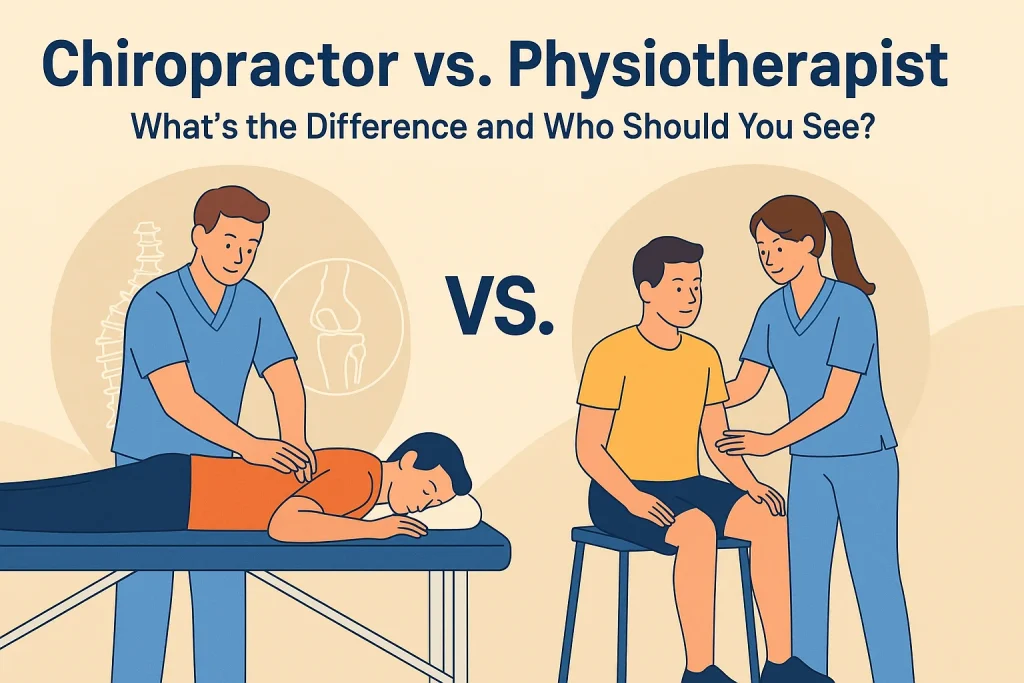
If you’re experiencing pain, recovering from an injury, or looking to optimize your movement and overall health, you may have considered seeing a chiropractor or a physiotherapist. Both professionals play crucial roles in the healthcare system and can help with a wide range of musculoskeletal issues. But what exactly is the difference between the two? Let’s break it down. Education & Training One key difference between chiropractors and physiotherapists is the amount of education required to enter their respective fields. Chiropractors complete a four-year Doctor of Chiropractic (DC) degree after completing an undergraduate program. This extensive training includes in-depth study of the nervous system, human anatomy, spinal health, biomechanics, and hands-on clinical experience. Physiotherapists typically complete a two-year Master’s degree in physiotherapy after their undergraduate studies. Their education focuses on movement science, rehabilitation, and physical function. Both professions require rigorous training and a deep understanding of the human body, ensuring they are well-equipped to provide expert care. Approach to Treatment While both chiropractors and physiotherapists treat musculoskeletal issues, they often have different approaches: Chiropractors focus on the relationship between the spine and the nervous system. They use spinal adjustments, manual therapy, and other techniques to restore alignment, relieve nerve interference, and improve overall function. Chiropractic care is often associated with reducing pain, improving mobility, and enhancing nervous system function. Physiotherapists focus on rehabilitation through exercise, manual therapy, and education. They design personalized treatment plans to restore movement and strength, often incorporating techniques such as soft tissue therapy, joint mobilizations, and rehabilitation exercises. What Conditions Do They Treat? Both chiropractors and physiotherapists treat a variety of conditions, including: Back and neck pain Sports injuries Postural issues Joint pain and stiffness Repetitive strain injuries Rehabilitation after surgery or injury Which Practitioner is Right for You? There is no one-size-fits-all answer—it depends on your specific needs and preferences. If you are looking for spinal adjustments, nervous system-focused care, or relief from conditions like sciatica or headaches, a chiropractor may be the right choice. If you need rehabilitation exercises, movement retraining, or post-surgical recovery support, a physiotherapist might be best suited for you. The good news? You don’t have to choose just one! Many people benefit from a combined approach, working with both chiropractors and physiotherapists to achieve optimal health and function. Final Thoughts Both chiropractors and physiotherapists are amazing practitioners who bring unique skills to the table. Whether you choose chiropractic care, physiotherapy, or a combination of both, the ultimate goal is to help you move better, feel better, and live a healthier life. If you’re unsure which option is right for you, book a free consultation or book an appointment, and let’s find the best approach for your needs! Book a Free Consultation Book an Appointment
Stronger Every Day: The Science-Backed Benefits of Strength Training

Incorporating strength training into your routine isn’t just about building muscle—it’s a game-changer for your overall health and longevity. Often overlooked in favor of cardio, resistance training plays a crucial role in maintaining a strong, resilient body while offering a host of mental and metabolic benefits. Whether you’re lifting weights, using resistance bands, or engaging in body-weight exercises, strength training helps improve bone density, boost metabolism, support joint health, and even enhance mood. Backed by research, it’s one of the most effective ways to maintain mobility, prevent chronic disease, and improve your quality of life at any age. Let’s explore the science behind strength training and why it deserves a permanent place in your wellness routine. 1. Enhances Musculoskeletal Health Engaging in strength training promotes the health of your muscles and bones. It helps maintain bone density, reducing the risk of osteoporosis, and combats age-related muscle loss, thereby preserving functional abilities. 2. Boosts Metabolic Rate Regular resistance training can increase lean muscle mass, which in turn elevates your resting metabolic rate. This means you’ll burn more calories even when not exercising, aiding in weight management. 3. Improves Mental Health Strength training has been linked to better mental health outcomes. Studies have shown it can reduce symptoms of anxiety and depression, enhance mood, and improve overall psychological well-being. 4. Enhances Quality of Life for Older Adults For individuals over 50, incorporating strength training into their routine is crucial. It helps maintain muscle mass, supports bone health, and improves balance, reducing the risk of falls and enhancing overall quality of life. 5. Supports Long-Term Health and Longevity Regular physical activity, including strength training, is associated with a longer, healthier life. It reduces the risk of chronic diseases, improves cardiovascular health, and supports overall bodily functions, contributing to increased life expectancy. Getting Started with Strength Training If you’re new to strength training, consider the following tips: Start Slow: Begin with lighter weights or body-weight exercises to learn proper form. Seek Professional Guidance: Consult with a fitness professional to create a personalized program and ensure exercises are performed correctly. Consistency is Key: Aim for regular sessions, gradually increasing intensity as your strength improves. Incorporating strength training into your routine can lead to significant improvements in health and well-being. Whether you’re a beginner or looking to refine your routine, having the right guidance can make all the difference. If you’re unsure where to start or want personalized recommendations for safe and effective exercises, schedule an appointment today! Let’s work together to build strength, improve mobility, and keep you feeling your best. Resources: https://pubmed.ncbi.nlm.nih.gov/32564299/ https://www.healthline.com/health/fitness/benefits-of-strength-training https://pubmed.ncbi.nlm.nih.gov/22777332/
Lift Smart, Stay Strong: Preventing Back Injuries with Proper Lifting Techniques

Whether you’re rearranging furniture, picking up groceries, working out in the gym, or lifting heavy equipment at work, using the right lifting techniques can be crucial for protecting your back. As a chiropractor, we see firsthand how improper lifting techniques contribute to back pain, muscle strains, and even long-term spinal issues. The good news? With the right approach, you can protect your body, reduce the risk of injury, and improve overall movement efficiency Safe Lifting Tips to Prevent Back Injury: Bend at your knees to lift with ease. Stand close to the load to maintain control and reduce strain. Position your feet shoulder-width apart for stability. Bend your knees and don’t arch your back to engage your leg muscles. Squat down and test the weight before attempting to lift. Ask for help if the object is too heavy or awkward to carry alone. Use your legs and arms, not your back or hips, to generate power for lifting. Move smoothly and avoid jerking motions that can strain muscles. Keep the load close to your body to maintain balance. Avoid twisting your spine while carrying the load. Instead, pivot with your feet. Lower the object carefully, bending your knees to control the descent. Incorporating these simple yet effective lifting techniques into your daily routine can make a significant difference in preventing back injuries. Being mindful of how you lift helps keep your spine strong and pain-free. If you’ve injured yourself while lifting, a chiropractor can help assess, diagnose, and treat the injury, getting you back to pain-free movement as quickly as possible Stay safe, lift smart, and protect your body for the long run! References: https://chiropractic.ca/lifting-tips-from-canadian-chiropractors/
Top 5 Myths About Chiropractic Treatment – Debunked!

Chiropractic care has become a trusted part of healthcare, but myths persist. Let’s take a closer look at the most common misconceptions: 1. Myth: Chiropractors Aren’t Real Doctors Fact: Chiropractors are regulated in all 10 Canadian provinces and are designated to use the title “doctor” after completing the extensive Doctor of Chiropractic degree program. Chiropractors undergo extensive education, including a 4-year Doctor of Chiropractic (DC) degree. They study anatomy, physiology, neurology, biomechanics, and hands-on clinical training. Chiropractors are licensed healthcare professionals qualified to diagnose and treat a variety of conditions. 2. Myth: Chiropractic Care Isn’t Safe Fact: Chiropractic care is widely recognized as a safe, non-invasive treatment option. Adverse effects are infrequent. Chiropractors use precise techniques tailored to each patient, minimizing any risk and prioritizing patient comfort and safety. 3. Myth: Adjustments Are Painful Fact: In general, adjustments or joint manipulations are not painful. Many patients experience relief during or immediately after an adjustment. The cracking sound often associated with adjustments is simply gas releasing from joints, not bones cracking. While some may feel mild soreness, it’s comparable to post-workout stiffness and typically resolves quickly. 4. Myth: You’ll Be Stuck in Ongoing Care Fact: Chiropractic care plans are customized. Depending on the patient and the condition, the recommended course of care may vary. Ultimately, the decision to continue care is yours. Some patients seek long-term care for wellness or injury prevention, while others visit only as needed. Chiropractors aim to empower patients, not make them dependent. 5. Myth: Chiropractors Only Treat Back Pain Fact: While back pain is a common reason to visit, chiropractors address a range of issues, including neck pain, headaches, extremity complaints, and injuries. They can also help improve overall wellness, fitness, nutrition, and lifestyle. Why Chiropractic Care? Chiropractic treatment is a safe, effective, and evidence-based approach to improving your overall health, managing pain, and enhancing your quality of life. It goes beyond simply addressing symptoms by targeting the root causes of musculoskeletal issues. Whether you’re dealing with chronic back pain, recovering from a sports injury, or seeking preventative care to maintain optimal function, chiropractic care offers personalized solutions tailored to your unique needs. Don’t let myths or misunderstandings hold you back from exploring its many benefits. By taking a proactive approach to your health, you can experience improved mobility, reduced pain, and a renewed sense of well-being. Invest in your health today—your body will thank you tomorrow!
Sit Less, Live More: Breaking Free from Sedentary Habits for a Healthier Spine
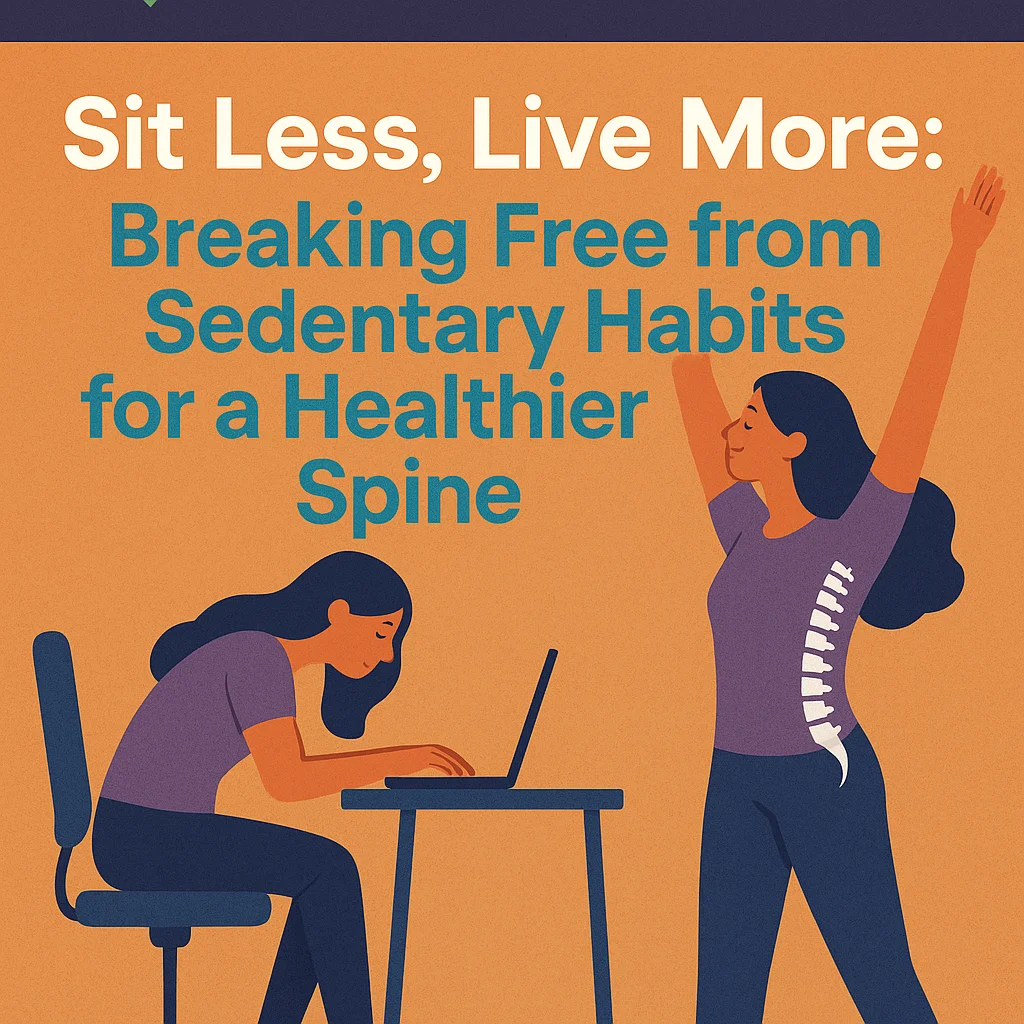
Chiropractic Care Your sedentary lifestyle may be affecting your health more than you think. Prolonged sitting or inactivity can have wide-ranging negative impacts on the human body, including increased risks of all-cause mortality, cardiovascular disease, cancer, diabetes, osteoporosis, and depression. A sedentary lifestyle refers to a routine with little to no exercise and excessive sitting or lying down. This may sound extreme, but even working at a desk for 8 hours a day falls into this category. On average, Canadian adults spend 9.6 hours a day being sedentary, and only about 50% meet national physical activity guidelines. Current physical activity guidelines recommend at least 150 minutes of moderate to vigorous-intensity aerobic exercise per week, with the addition of strength training exercises at least twice a week. Moderate to vigorous-intensity exercise includes activities that make you sweat and breathe harder. Engaging in at least 150 minutes of activity per week can reduce the risk of premature death, heart disease, stroke, high blood pressure, certain cancers, type 2 diabetes, osteoporosis, and obesity. Tips for Getting and Staying Active: Start gradually: ease into a routine to avoid feeling overwhelmed. Incorporate activity into daily life: walk to run errands, bike to work, get off the bus a stop or two early, or take the stairs at work or in your apartment. Choose activities you enjoy: doing something you like makes it feel less like a chore. Get friends and family involved: including loved ones in your routine can make it more fun and engaging. Join a group: scheduled workout clubs or fitness groups add accountability. Stick with it: after 2-3 months, being active will start to feel like a natural part of your routine. Visit Your Chiropractor If you’re experiencing discomfort from a sedentary lifestyle, your chiropractor can help you get back on track. Chiropractic care not only focuses on spinal health but also improves mobility and overall well-being, allowing you to stay active and healthy. By combining chiropractic care with regular physical activity, you can reduce the risk of long-term health problems associated with inactivity. There are many resources to help you kickstart a healthier and more active lifestyle: ParticipACTION Heart and Stroke Foundation – Get Active American Heart Association – Easy Ways to Move More National Heart, Lung, and Blood Institute – Getting Active Resources: https://www.heartandstroke.ca/-/media/pdf-files/healthy-living/csep_guidelines_handbook.pdf?rev=-1 https://www.participaction.com/the-science/key-facts-and-stats/ https://www.ncbi.nlm.nih.gov/pmc/articles/PMC7700832/
Headache Relief: How Chiropractic Care Can Help
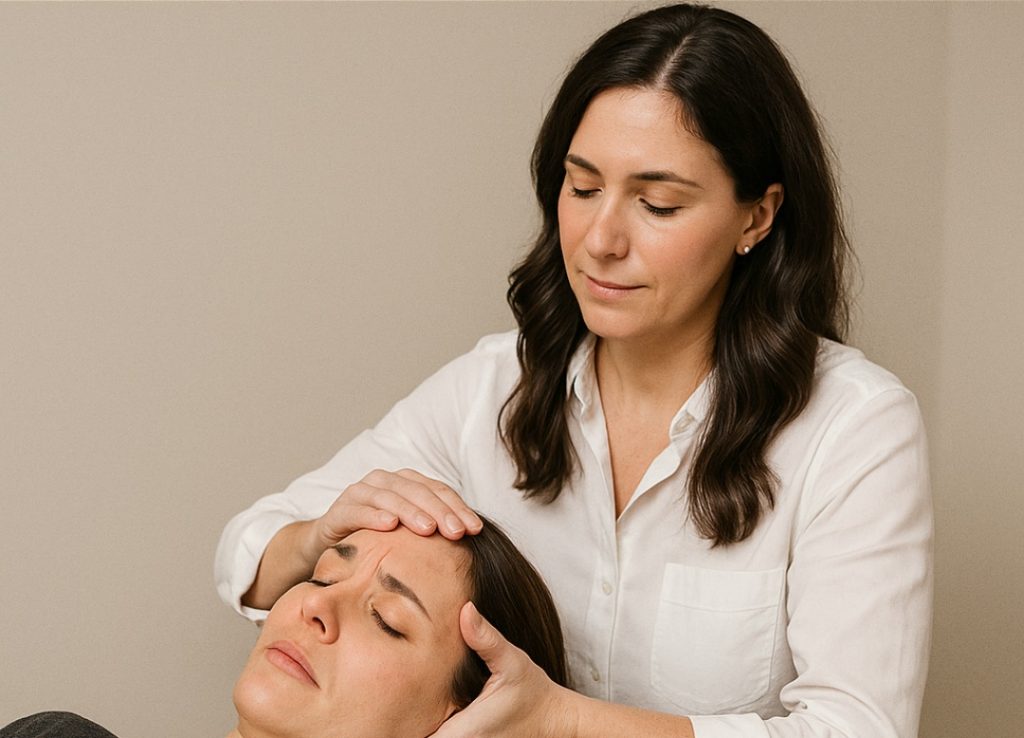
Headaches can significantly impact an individual’s quality of life but are often under-diagnosed and under treated. Chiropractors are highly educated and trained individuals who can diagnose, manage, and treat various types of headaches. Types of Headaches Tension type headaches – These headaches are typically a result of muscular contractions, often triggered by stress, depression, anxiety, or head injury. Symptoms include a dull, non-pulsatile, bilateral pressure sensation that commonly wraps around the head in a band-like pattern. Migraine headaches – Migraine headaches typically cause pain on one side of the head and are often accompanied by nausea, vomiting, and sensitivity to light or sound. They may also involve a migraine aura, which includes visual or sensory symptoms that occur before the headache. Cervicogenic headaches – These headaches originate from structures and tissues in the neck. They are often unilateral (one-sided) and aggravated by neck movements or certain positions. Cervicogenic headaches are a common cause of chronic headaches and are often misdiagnosed. Chiropractic Care and Headaches Chiropractors can assess, diagnose, and treat headaches using evidence-based practices. Chiropractic care is recognized as a safe and effective treatment for tension-type, migraine, and cervicogenic headaches, helping to reduce symptoms, intensity, and frequency. In cases where further intervention is required, chiropractors can refer patients to the appropriate healthcare professionals. Treatment options include 1. Manual therapy 2. Soft tissue therapy 3. Modalities including acupuncture and electrical stimulation 4. Rehabilitative exercise 5. Lifestyle changes and education 6. Referral to other practitioners Taking control of your headaches with chiropractic care is a proactive step toward improving your quality of life. By addressing the root cause of your pain, chiropractors can help you find long-lasting relief, reduce your dependency on medication, and empower you with lifestyle changes that prevent future headaches. If you or someone you know is suffering from chronic headaches, consider visiting your local chiropractor for a thorough assessment and treatment plan tailored to your needs. Resources https://chiropractic.ca/6-ways-chiropractic-care-can-help-manage-headaches/ https://bestpractice.bmj.com/
